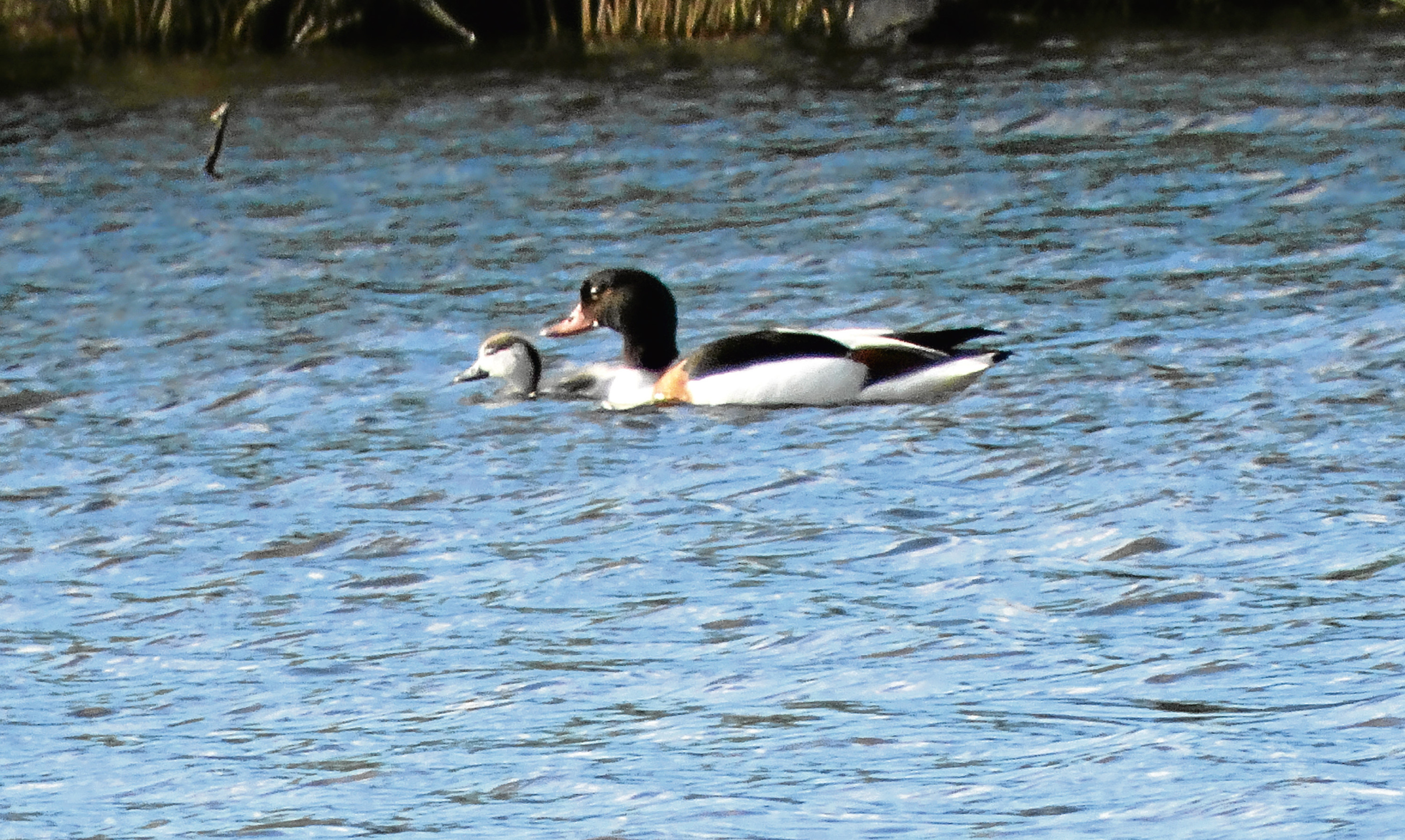I’m having fun with a new pair of binoculars which are transforming my walks with Inka.
They are marketed as auto focus or perma focus which is market speak for focus free and means I never have to adjust them.
The 10×50 magnification gives clear focus from approximately 50ft to infinity.
This is handy, for instance, in identifying males and females of some species at longer distances.
Detail is blurred at close distance such as in the garden but a pocket- sized monocular, which I have had since I was a teenager, is ideal for short ranges.
Unexpected visitors at the wee loch at the foot of Glenesk – and a first so far as I am concerned – are a pair of shelducks and a duckling.
Shelducks are our largest duck and confound the general rule in the duck world that the females are less colourful and conspicuous than the drakes.
Both sexes have boldly contrasting black and white plumage with a broad chestnut band round the chest and backs and the drake is identified by the prominent knob at the base of the red bill.
I associate these ducks with the coast and nesting in the sand dunes, so it is unusual to find this pair so far inland.
It is strange too that I should have seen the birds for the first time only on Monday when the duckling looks to be about a fortnight old. The eggs are incubated by the duck for 30 days and there would have been a period of mating display and nest building.
So, this pair may have been in the glen for about two months and I hadn’t seen them before.
Because her bright plumage would be an invitation to predators if she nested in the open, the duck chooses a rabbit hole or well concealed hollow to make her down-lined nest of dried grasses.
She lays about a dozen eggs but it looks as though predators – as likely as not some of the many local buzzards – have left her with just one surviving duckling.
Roe deer encounter
With my new binoculars I spied a roe deer doe feeding at the top end of the loch and I thought I could get a picture of her.
The wind was blowing my scent away from her and I made a wide detour to carefully come down to where I had seen her.
I was well concealed by branches and steadying myself to take a photograph when something spooked her.
It wasn’t Inka, who was patiently sitting well behind me and out of her sight.
Perhaps the late afternoon sun was reflecting off the lens of the camera – but she was up and away.
Roe deer drop their calfies between mid-May to mid-June and leave them hidden in deep undergrowth throughout the day, returning in the evening to feed them.
I watched her canter off but, as a defensive distraction, probably in the opposite direction to her calf.
End of day
It was turning into a near perfect evening.
The clouds had cleared and there was still heat in the sun.
I sat for a while on a fallen tree, watching the world go by.
The breeze was putting a ripple on the water and soughing through the trees on the far side of the loch.
Two mallard drakes circled overhead making their quiet, rasping call and dropped sharply down to the loch, webbed feet thrust forward acting like brakes, to make a splashy landing in a shower of spray.
They were still in their breeding plumage, looking their best and their iridescent green heads positively gleamed. Meanwhile, Inka was getting impatient – I came out for a walk, he was saying.
The walk back to the car is through a mature birch wood.
The sun was starting to dip behind the hills, casting long fingers of shadow.
Splashes of sunlight filtered through the fresh green leaves shivering in the breeze, creating a glittering mosaic of movement and colour.
Inka was ready to be fed the moment we were in the door and the Doyenne suggested the sun was sufficiently far over the yardarm for me to pour us both a glass of cool wine.
There are worse worlds to be in.
Garden activity
Hedge sparrows and house sparrows are both on the RSPB red endangered list but they are regular visitors to our garden.
Hedge sparrows are busy feeding a second brood of chicks in one of the nest boxes.
The other box has so far produced just the one brood but there’s time for that to change.
House sparrows nest nearby and bring their newly fledged chicks to forage in the flower beds and below the shrubs.
The chicks are still reliant to an extent on the parent birds and very demanding, rapidly beating their wings to attract their parents to feed them.
All day we are entertained by the sound of the sparrows and other finches coffee shopping among themselves in the security of the thick foliage of the old hawthorn tree in the corner of the garden.
